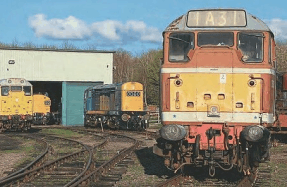Going Dutch The Class 77 story

THE general story of the 1500V DC EM2 express passenger electrics built for the Manchester-Sheffield-Wath (MSW) ‘Woodhead’ electrification scheme in the early 1950s is well known. Just seven members strong (pre-TOPS Nos. 27000-27006), they were declared redundant in 1968 and sold to Nederlandse Spoorwegen, the Dutch national railway operator, in 1969 where they gave excellent service until retired for asecond time in 1986.
However, it could have been a very different matter had British Railways continued electrification at 1500V DC rather than switching to 25kV AC as the new standard.
Electrification of the former Great Central route over the Pennines, via Woodhead Tunnel, had been mooted for years before the first comprehensive plan was published by the LNER in 1936. Calling for nine express passenger locomotives, plus 69 for mixed traffic and 10 for banking duties, the planned 88-strong fleet would replace 181 steam engines on a more than two for one basis.

Work started on wiring in 1937, and the prototype Bo+Bo EM1 (Class 76) mixed-traffic locomotive, No. 6701, was released into traffic in February 1941. Wearing LNER apple green, it was designed by Sir Nigel Gresley and spent some time on test on the 1500V DC Manchester-Altrincham line, which had been electrified in 1931. However, with the Second World War raging, the MSW electrification was shelved and the loco went into store.
The banking locos would be rebuilt from the 10 North Eastern Railway EF1 locomotives constructed for the Shildon scheme in 1914 and 1919. Little is known about what was envisioned for the nine express passenger machines, although a proposal was made by the Swiss Locomotive & Machine Works (SLM) of Winterthur in 1939 for a 55ft-long 4-6-4 design, suggesting an arrangement similar to the NER’s EE1.
After the war, attention turned to rebuilding the country’s patched up railway system and the MSW electrification was intended to be one of the showpieces of this effort.
EM1 No. 6701, by now renumbered No. 6000, was lent to Nederlandse Spoorwegen in 1947 to assist with its huge motive power shortage, the Dutch having extensively electrified at 1,500V DC in the interwar period. The arrangement was not entirely altruistic, as the LNER was desperate to really test No. 6000 to the limit. While the prototype EM1 proved to be exceptionally reliable, its work in the Netherlands did highlight several major issues – particularly an inclination for the lead axle to lift up under acceleration, while the ride quality at speed left a lot to be desired.


INITIAL EM2 ORDER
“The expectation
You’re reading a preview, subscribe to read more.
Start your free 30 days





